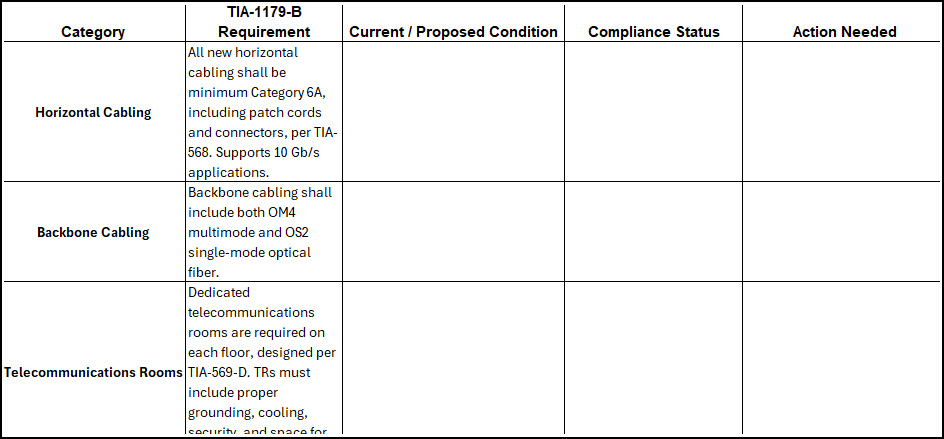Designing and upgrading healthcare facilities has never been more complex. Hospitals and medical centers must support electronic health records (EHR), imaging systems, telemedicine, mobile clinical workflows, and dense wireless coverage, all while maintaining compliance with healthcare-specific infrastructure standards. One of the most critical standards guiding this work is the TIA-1179-B Healthcare Facility Telecommunications Infrastructure Standard.
Many design teams, despite their experience, face challenges in verifying that their plans meet every aspect of the standard. That’s where a Compliance Matrix becomes an essential tool.
Why TIA-1179-B Matters
Unlike general commercial buildings, healthcare facilities require far higher levels of connectivity, resiliency, and security. TIA-1179-B provides a structured framework to ensure that:
- Cabling systems are future-ready - Category 6A cabling is the minimum requirement for horizontal runs, supporting 10 Gbps applications and beyond
- Backbone networks are scalable - The standard calls for OM4 multimode and OS2 single-mode fiber to support high-bandwidth applications across large campuses
- Telecommunications spaces are reliable - Each floor should include dedicated telecom rooms with adequate grounding, cooling, and access control
- Port densities align with clinical needs - Different functional areas (e.g., imaging, critical care, outpatient) require higher outlet counts to support medical devices and IT equipment
- Security and compliance are built in - Physical access controls, proper grounding, and cable management reduce risks and support HIPAA requirements
Ultimately, TIA-1179-B provides the foundation for healthcare infrastructure that prioritizes safety, reliability, and future scalability.
What Is a Compliance Matrix?
A Compliance Matrix is a simple but powerful validation tool. It lists each requirement from TIA-1179-B and provides a clear framework for checking design documents, drawings, or existing infrastructure against those requirements.
A typical matrix includes:
- Category (e.g., cabling, backbone, telecom rooms, labeling, security)
- Standard requirement (from TIA-1179-B)
- Design or facility condition (planned or existing)
- Compliance status (compliant, non-compliant, partial)
- Action needed (upgrade, redesign, additional outlets, etc.)

Benefits of Using a Compliance Matrix
1. Speed and Clarity
- Project teams can quickly identify gaps in design without sifting through hundreds of pages of standards
- Non-compliant items are highlighted clearly, allowing teams to act early
2. Consistency Across Projects
- Regardless of project or complexity, the same matrix can be applied
- Ensures all projects are reviewed consistently
3. Improved Stakeholder Communication
- Transform technical standards into actionable items
- Executives, architects, engineers, and IT leaders can all see where compliance stands without needing to interpret technical jargon
4. Risk Mitigation
- Early validation of compliance/non-compliance
- Reduce the risk of costly redesigns, change orders, and downtime caused by overlooked deficiencies
5. Future-Proofing Investments
- Use for new projects or redesigns
- Ensure infrastructure can support upcoming technologies
Putting the Compliance Matrix into Practice
When applied during the design phase, the matrix ensures drawings and specifications align with standards. For existing facilities, it becomes a checklist to guide assessments, upgrades, and modernization projects.
A practical workflow looks like this:
- List Standards Requirements - Extract relevant TIA-1179-B clauses for cabling, backbone, telecom rooms, security, etc.
- Assess Design or Facility - Compare drawings or site conditions against each requirement
- Mark Compliance Status - Use clear indicators (Compliant, Non-Compliant, Partial)
- Prioritize Remediation - Focus on high-impact items first, such as backbone fiber upgrades or telecom room retrofits
- Document for Stakeholders - Share the completed matrix with project teams to align decisions and budgets
Conclusion
Validating healthcare designs against TIA-1179-B doesn’t need to be overwhelming. By adopting a Compliance Matrix, healthcare organizations, consultants, and design teams gain a fast, repeatable, and transparent method for ensuring their facilities are built to standard. Download our Compliance Matrix and start your journey toward standards compliance within your healthcare facilities. The result? Safer, more resilient, and future-ready healthcare environments that support critical clinical operations today, and whatever innovations tomorrow bring.



